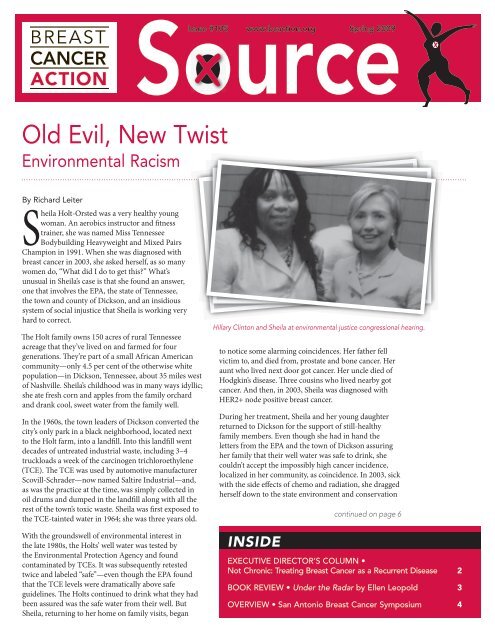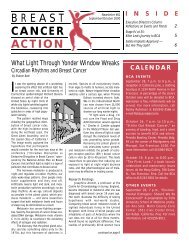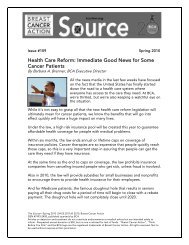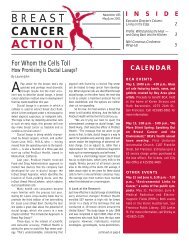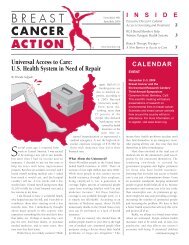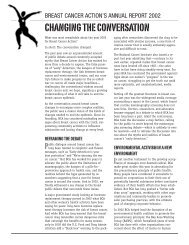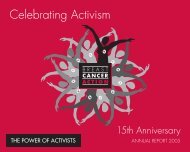Old Evil, New Twist - Return to Home Page - Breast Cancer Action
Old Evil, New Twist - Return to Home Page - Breast Cancer Action
Old Evil, New Twist - Return to Home Page - Breast Cancer Action
- No tags were found...
You also want an ePaper? Increase the reach of your titles
YUMPU automatically turns print PDFs into web optimized ePapers that Google loves.
<strong>Old</strong> <strong>Evil</strong>, <strong>New</strong> <strong>Twist</strong>Environmental RacismSourceIssue #105 www.bcaction.org Spring 2009By Richard LeiterSheila Holt-Orsted was a very healthy youngwoman. An aerobics instruc<strong>to</strong>r and fitnesstrainer, she was named Miss TennesseeBodybuilding Heavyweight and Mixed PairsChampion in 1991. When she was diagnosed withbreast cancer in 2003, she asked herself, as so manywomen do, “What did I do <strong>to</strong> get this?” What’sunusual in Sheila’s case is that she found an answer,one that involves the EPA, the state of Tennessee,the <strong>to</strong>wn and county of Dickson, and an insidioussystem of social injustice that Sheila is working veryhard <strong>to</strong> correct.The Holt family owns 150 acres of rural Tennesseeacreage that they’ve lived on and farmed for fourgenerations. They’re part of a small African Americancommunity—only 4.5 per cent of the otherwise whitepopulation—in Dickson, Tennessee, about 35 miles wes<strong>to</strong>f Nashville. Sheila’s childhood was in many ways idyllic;she ate fresh corn and apples from the family orchardand drank cool, sweet water from the family well.In the 1960s, the <strong>to</strong>wn leaders of Dickson converted thecity’s only park in a black neighborhood, located next<strong>to</strong> the Holt farm, in<strong>to</strong> a landfill. In<strong>to</strong> this landfill wentdecades of untreated industrial waste, including 3–4truckloads a week of the carcinogen trichloroethylene(TCE). The TCE was used by au<strong>to</strong>motive manufacturerScovill-Schrader—now named Saltire Industrial—and,as was the practice at the time, was simply collected inoil drums and dumped in the landfill along with all therest of the <strong>to</strong>wn’s <strong>to</strong>xic waste. Sheila was first exposed <strong>to</strong>the TCE-tainted water in 1964; she was three years old.With the groundswell of environmental interest inthe late 1980s, the Holts’ well water was tested bythe Environmental Protection Agency and foundcontaminated by TCEs. It was subsequently retestedtwice and labeled “safe”—even though the EPA foundthat the TCE levels were dramatically above safeguidelines. The Holts continued <strong>to</strong> drink what they hadbeen assured was the safe water from their well. ButSheila, returning <strong>to</strong> her home on family visits, beganHillary Clin<strong>to</strong>n and Sheila at environmental justice congressional hearing.<strong>to</strong> notice some alarming coincidences. Her father fellvictim <strong>to</strong>, and died from, prostate and bone cancer. Heraunt who lived next door got cancer. Her uncle died ofHodgkin’s disease. Three cousins who lived nearby gotcancer. And then, in 2003, Sheila was diagnosed withHER2+ node positive breast cancer.During her treatment, Sheila and her young daughterreturned <strong>to</strong> Dickson for the support of still-healthyfamily members. Even though she had in hand theletters from the EPA and the <strong>to</strong>wn of Dickson assuringher family that their well water was safe <strong>to</strong> drink, shecouldn’t accept the impossibly high cancer incidence,localized in her community, as coincidence. In 2003, sickwith the side effects of chemo and radiation, she draggedherself down <strong>to</strong> the state environment and conservationINSIDEcontinued on page 6Not Chronic: Treating <strong>Breast</strong> <strong>Cancer</strong> as a Recurrent Disease 2Under the Radar by Ellen Leopold 3 4
2 FROM THE EXECUTIVE DIRECTORNot ChronicTreating <strong>Breast</strong> <strong>Cancer</strong> as a Recurrent DiseaseBy Barbara A. BrennerAs everyone familiar with breast cancer knows, there is noavailable cure for metastatic breast cancer (breast cancerthat has spread beyond the breast <strong>to</strong> life-sustainingorgans). In fact, metastatic breast cancer will kill awoman who has it unless something else kills her first.The good news is that some treatments can extend the lives ofsome women with metastatic disease by keeping metastaticbreast cancer from advancing, at least for a period of time. Thesetreatments are not without side effects, however. Some of thoseside effects are devastating.One thing I find interesting at this moment is that advances intreatment have led the cancer industry <strong>to</strong> begin <strong>to</strong> talk of breastcancer as a “chronic disease.”The term “chronic” appears <strong>to</strong> have many meanings. The use ofthe term in the context of breast cancer—metastatic or not—conveys an approach <strong>to</strong>, and an attitude about, the disease thatpoints in the wrong direction.Consider how Wikipedia defines “chronic” in the medicalsetting:A chronic disease is a disease that is long-lasting or recurrent.The term “chronic” describes the course of the disease, or its rateof onset and development. A chronic course is distinguishedfrom a recurrent course; recurrent diseases relapse repeatedly,with periods of remission in between.By this definition, metastatic breast cancer is recurrent, notchronic. While this might seem like an academic dispute,consider it from the viewpoint of a woman with metastaticbreast cancer. Rita Arditti, a cancer activist and active memberof the Women’s Community <strong>Cancer</strong> Project in Bos<strong>to</strong>n, and awoman living with metastatic breast cancer, has this <strong>to</strong> say onthe subject:<strong>Cancer</strong> is a progressive disease regardless of “personalmanagement” of the disease. In the case of diabetes, lifestylechanges (diet, exercise) are crucial because many times theycan allow the patient <strong>to</strong> avoid insulin or other treatments.Apparently, heart disease is in the same boat:lifestyle changes are crucial and, in many cases, havebeen able <strong>to</strong> control the disease.What are the lifestyle changes I can make thatwould put me in that boat? In fact, the whole issueof patient compliance is key for people with chronicillness. For cancer patients, I guess compliancemeans showing up for chemo or taking your pills.The other important point is that the treatments forcancer are, in some cases, worse than the diseaseand that secondary cancers are often a result of thetreatment of the first cancer. Injecting insulin daily isno fun, but the side effects of some cancer therapiesare frankly horrendous, and the uncertainty of theireffectiveness adds <strong>to</strong> the burden.It is one thing is <strong>to</strong> take insulin or some othertreatment that is known <strong>to</strong> help. But cancer patientsoften receive treatment with only the “hope” that itwill improve their cancer outcome, which may meanmonths of bad side effects for nothing. That adds abig stress fac<strong>to</strong>r <strong>to</strong> the whole picture. Uncertainty isall over the place with cancer, regardless of attitude,because we know so little and can do practicallynothing <strong>to</strong> improve the situation. Not having anycontrol is in itself terribly debilitating.continued on page 11
SPRING 2009 3BOOK REVIEWUnder the Radar:<strong>Cancer</strong> and the Cold Warby Ellen LeopoldRutgers University Press, 2009; $25.95Reviewed by Elayne CliftAmong my earliest memories are whispered grieving overa young mother in my <strong>to</strong>wn dying of breast cancer, greenx-rayed pictures of the bones in my feet when I needednew shoes, and ducking under my school desk duringnuclear attack practice drills. These events and others, from myyouth <strong>to</strong> my work in the women’s health movement 30 yearslater, filled my mind as I read Ellen Leopold’s well-documented,informative exposé of the relationship between Cold Warpolitics and cancer research and treatment.Leopold humanizes the s<strong>to</strong>ry by introducing Irma Natanson, ayoung mother in Kansas diagnosed with breast cancer in 1955.Natanson, one of the first women treated with cobalt radiation,suffered tragic results. We follow her s<strong>to</strong>ry, including the lawsuitshe brought against her radiologist, setting a precedent forinformed consent. A version of this account appeared in the Fall2004 issue of the Source, #83.Cobalt radiation in the 1950s was “inextricably tied <strong>to</strong> thehis<strong>to</strong>ry of the United States in the decade following the endof World War II.” Leopold carefully fleshes out this premise,revealing how even language fueled a postwar mentality inwhich communism, along with cancer, had <strong>to</strong> be defeated.Terms like “the cancer of communism” were commonly usedin Cold War propaganda, eachword having the power <strong>to</strong>terrorize, each being framed asa malignant parasite.We learn how a civilianeconomy more concernedwith profit than people came <strong>to</strong> rely on nuclear by-products,even in light of Hiroshima, even as nuclear testing in Nevadaand the Pacific began <strong>to</strong> yield worrisome outcomes, even aswhistleblowers in the medical and scientific communities werebranded “poor scientists” or “communists.” Leopold clearlyilluminates the relationship between the military, medicine, andthe nuclear industry.We learn that secret experiments involving the A<strong>to</strong>mic EnergyCommission, as well as the military and medical communities,were conducted largely on people of color as well as terminallyill patients <strong>to</strong> determine the effects of radiation on humans and<strong>to</strong> assess <strong>to</strong>xicity in cancer treatment. (Women were especiallyvulnerable <strong>to</strong> such treatment.) Often compared <strong>to</strong> the Tuskegeestudies of black men with syphilis, experiments involving wholebody radiation <strong>to</strong>ok place at such venerable institutions asM.D. Anderson <strong>Cancer</strong> Center, the naval hospital in Bethesda,continued on page 755 <strong>New</strong> Montgomery St.Suite 323San Francisco, CA 94105Phone: 415/243-9301Toll free: 877/2 -STOP-BCFax: 415/243-3996info@bcaction.orgwww.bcaction.orgBOARD MEMBERSDenise Wells, PresidentJane Sprague Zones, Vice PresidentAdrienne Torf, TreasurerBhavna Shamasunder, SecretaryClaudia Cappio, Diane Carr, Lindsey Collins,Elaine Costello, Tori Freeman, Dorothy Geoghegan,JoAnn Loulan, Belle Shayer (emerita),Lee Ann Slinkard, Dawn SurrattSTAFFBarbara A. Brenner, Executive Direc<strong>to</strong>rJoyce Bichler, Deputy Direc<strong>to</strong>rCristina Carrasquillo, Program Coordina<strong>to</strong>rZoë Chris<strong>to</strong>pher, Office ManagerSarah Harding, Individual Gifts OfficerAmy Harris, Development Direc<strong>to</strong>rKasha Ho, Program AssociateRichard Leiter, Communications Direc<strong>to</strong>rBCA SOURCEEdi<strong>to</strong>r: Richard LeiterEdi<strong>to</strong>rial Board: Barbara Brenner, Sarah Harding,Joyce Bichler, and Cristina CarrasquilloCopyediting: Robert GomezLayout: Yvonne Day, Y. Day Designs© BCA 2009, ISSN #1933-2408, published bimonthlyby BCA. Arti cles on detection and treat ment do notconstitute endorsements but are intended solely <strong>to</strong>inform. Call or e-mail for permission before reprinting.To subscribe, send name and address <strong>to</strong> BCA.Requested annual donation is $50, but no one isrefused for lack of funds.“<strong>Breast</strong> <strong>Cancer</strong> <strong>Action</strong>” and the BCA logo are the registeredtrademarks of <strong>Breast</strong> <strong>Cancer</strong> <strong>Action</strong>. All rights reserved.Not <strong>to</strong> be used without express written permission.
4 San An<strong>to</strong>nio <strong>Breast</strong> <strong>Cancer</strong> Symposium2008 OverviewBy Jane Zones and Barbara BrennerBCA staffers Barbara Brenner and Allison Young, andboard member Jane Zones, attended the San An<strong>to</strong>nio<strong>Breast</strong> <strong>Cancer</strong> Symposium (SABCS) in December 2008.More than 8,000 physicians and researchers attendedthe conference this year, along with droves of drug and devicemanufacturers and a small number of breast cancer advocates.The symposium consisted of four days of ten- <strong>to</strong> 30-minutepresentations, six sessions where numerous “posters” (smallerscalediscussions) were presented, special sponsored sessionsin the evenings, and a variety of other events. Most scientificpresentations <strong>to</strong>ok place in a vast audi<strong>to</strong>rium that held thousandsof participants. Speakers and their slides were projected on hugescreens that hung throughout the hall. No more than five minutesfor questions were provided for any presentation.This article highlights some of the themes of the conference.You can visit our web site <strong>to</strong> retrieve more detailed descriptionsof the various events we attended. And abstracts and slidesfrom most of the presentations are online at www.sabcs.org,where you can log on as a guest for complete access.Metastasis—Finally on the Radar ScreenAs most people dealing with breast cancer know, once thedisease has metastasized (spread from the breast <strong>to</strong> lifesustainingorgans or <strong>to</strong> bone), it cannot be cured. We desperatelyneed <strong>to</strong> figure out how <strong>to</strong> prevent metastasis from occurring andhow <strong>to</strong> treat it more effectively when it does occur.Metastasis got a lot more attention at SABCS this year,and that’s a good thing. There were four major overviewpresentations on metastasis: on circulating cancer cells, byKlaus Pantel; tumor “self-seeding,” by Larry Nor<strong>to</strong>n; metastasissuppressor genes, by Patricia Steeg; and the unique aspects ofbreast cancer metastasis as distinguished from lung and coloncancer metastasis, by Joan Massagué. Massagué is coauthor ofa special article on this <strong>to</strong>pic in the December 25, 2008, issueof the <strong>New</strong> England Journal of Medicine.This is important work, especially in the ongoing effort <strong>to</strong>individualize care, treat only those who would benefit fromparticular treatments, and more effectively treat metastaticdisease. You can find more details about these presentations onBCA’s web site.Overcoming Drug Resistance:How <strong>to</strong> Make Drugs Keep WorkingSome women treated with tamoxifen develop recurrences,or metastases, indicating that the drug has s<strong>to</strong>pped working.Indeed, development of resistance in some patients is foundwith all cancer drugs. Several of the sessions at SABCS dealtwith overcoming Herceptin resistance.“Signal transduction inhibi<strong>to</strong>rs” (STIs) are drugs like Herceptin(trastuzumab) that inhibit signals between cells that areinvolved in the cancer promotion process. Stephen Johnsonpresented a theory that resistance <strong>to</strong> tamoxifen can beovercome or prevented by giving an additional STI drug.Johnson made it clear that his theory is just that, and that itis not yet ready for clinical application. Among other things,performing biopsies will be necessary <strong>to</strong> understand what cellpathways are active in a given patient so that the correct STIcan be chosen <strong>to</strong> inhibit that pathway. While Johnson was clearthat understanding of this process is still being developed, wefeared that some of the clinicians in attendance would comeaway thinking that combining an STI with a hormonal therapywill overcome resistance.It’s still uncertain who is likely <strong>to</strong> develop resistance. Will thedoc<strong>to</strong>rs who read about this presentation decide <strong>to</strong> give bothdrugs <strong>to</strong> everyone so that they’ll reduce the risk in the oneswho will benefit? Will the result be yet more treatment—andmore expense and more unnecessary side effects as we graspfor anything that might keep patients alive?Sequencing Hormonal TreatmentsA number of presentations addressed combining hormonaltreatments with other drugs and the sequencing of drugtreatments <strong>to</strong> maximize benefit.Not long after aromatase inhibi<strong>to</strong>rs (AIs) came on the scenefor adjuvant treatment of breast cancer <strong>to</strong> reduce risk ofrecurrence, the medical community began <strong>to</strong> ask whetherpatients already on tamoxifen would do better by beingswitched <strong>to</strong> an AI. And trials have been reported at previousSABCS meetings looking at the benefits of switching.We heard five different presentations that considered whichhormonal drugs <strong>to</strong> prescribe, in what order, and whether theorder mattered: Abstracts 11 (lasofoxifene [SERM] <strong>to</strong> reducerisk of breast cancer, 12 (meta-analysis of switching studiesof tamoxifen and AIs), 13 (letrozole and tamoxifen, aloneand sequenced), 14 (tamoxifen alone vs. tamoxifen switched<strong>to</strong> anastrozole), and 15 (tamoxifen vs. tamoxifen switched <strong>to</strong>exemestane). A more complete description of these abstractscan also be found on BCA’s web site at www.bcaction.org.So, what’s the take-home for all of these studies? It seems <strong>to</strong> bethat the drumbeat for AIs continues <strong>to</strong> build, though whichone <strong>to</strong> give, whether <strong>to</strong> give tamoxifen first, and how long <strong>to</strong>continue treatment remain unanswered questions. We havemore information, but not more knowledge.continued on page 5
SPRING 2009 5continued from page 4There are several other things <strong>to</strong> note about these studies:x Many of them found statistically significant differences. Keepin mind that “statistically significant” does not mean “large” or“meaningful.” What it means is that the phenomenon is verylikely real, not a chance outcome.x Several of these studies involved unblinding of the trials andcrossover, meaning that women in the “control” arm of thestudy could then get the “treatment” being offered in the study.Crossover seriously complicates the analysis of results and verylikely biases the results in favor of AIs. While the reason forallowing crossover is compelling—if something seems <strong>to</strong> work,shouldn’t everyone have the chance <strong>to</strong> get it?—the practiceundermines the results of the trials. Wouldn’t women be willing<strong>to</strong> forego unblinding and crossover if they unders<strong>to</strong>od the need<strong>to</strong> have more reliable trial results? Shouldn’t we ask them?x Most of these trials were funded by the companies whose drugswere being tested.ImagingThere were a number of talks on breast cancer imaging, both fordetection (screening) and for making a more precise diagnosis aftera tumor is detected.Ultrasound in <strong>Breast</strong> <strong>Cancer</strong> Screening—Wendie Berg, aradiologist, started from the premise that mammography is thegold standard but noted that some subgroups of women may notbenefit from mammography. She thinks that women at high riskof developing breast cancer should get MRIs for screening underthe American <strong>Cancer</strong> Society’s guidelines. And she also maintainsthat women getting MRIs and mammograms don’t need <strong>to</strong> doultrasound, <strong>to</strong>o.But for women at intermediate risk, Berg finds lots of things <strong>to</strong>favor ultrasound: it’s relatively inexpensive, widely available, notradiation based, and well <strong>to</strong>lerated. The ongoing trial of ultrasoundfor screening, ACCRIN 666, which published its first results inJAMA in May 2008, shows that ultrasound is good at findingsmall lesions and node-negative disease, but there are a lot of falsepositives leading <strong>to</strong> unnecessary biopsies. Of course, this happenswith every detection method currently in use.Issues of technologist training and insurance reimbursementalso need <strong>to</strong> be resolved. And, as is always the case whenever thediscussion is about screening, Berg pointed out that ultrasoundsupplements but doesn’t replace mammography. It seems we’llalways have mammograms. So much for progress.MRI as a Diagnostic Tool—Monica Morrow is a surgicaloncologist who heads Memorial Sloan-Kettering <strong>Cancer</strong> Center’s<strong>Breast</strong> Service. Her major research interest is the application ofknowledge from clinical trials <strong>to</strong> daily surgical practice, and hertalk was a beautiful example of this.MRI is used in detecting breast cancer in asymp<strong>to</strong>matic women(screening) and in providing information <strong>to</strong> improve patien<strong>to</strong>utcome in women with breast cancer (diagnosis). Morrowaddressed MRI’s use as a diagnostic <strong>to</strong>ol only. The potential benefitsof MRI in diagnosis are <strong>to</strong> refine decisions about breast conservationtherapy, determine the extent of the tumor, identify potentialcontralateral cancer, and decrease the risk of local recurrence.In a range of studies, the <strong>to</strong>tal number of mastec<strong>to</strong>mies ispersistently double in women who have MRI. Furthermore, havingMRI delays surgery for an average of three weeks. DiagnosisrelatedMRI studies have been retrospective and not randomized.Women who undergo MRI are on average six years younger and areselected for imaging because they are more likely <strong>to</strong> benefit, whichwould result in more favorable research outcomes for MRI. Even so,no advantage has been shown for such imaging.Morrow summed up by saying that MRI finds more cancer, butwhat is found is not clinically relevant. Neither short-term surgicaloutcomes nor long-term local control or contralateral cancer ratesare improved with MRI. Because of this, she recommends MRIonly for BRCA1 and 2 carriers, those who present with positivelymph nodes, those who are being assessed for neoadjuvanttherapy, or those whose diagnosis is not resolved by physical exam,mammogram, and ultrasound.“The routine use of MRI in cancer patients requires some evidenceof clinical benefit,” Morrow said, as she ended her lecture. “To date,this does not exist.”Morrow’s presentation was followed by a report on the first andonly prospective study of MRI, the COMICE trial, which wassponsored by the research arm of the British National HealthService. (England and Canada sponsor significant research onactual effectiveness as a means of cost containment). The results ofCOMICE substantiated Morrow’s perspective.In SummaryFor people who are not medical researchers, attending SABCS wasa major challenge, but it was important for those of us who followthe progression from ideas <strong>to</strong> treatment. Our web site includes dailyaccounts of events we attended, and slides and abstracts are availableon the SABCS web site. We encourage you <strong>to</strong> make use of thisinformation. XJane Zones is a medical sociologist and a BCA board member.ALERTS BY E-MAIL=Want up-<strong>to</strong>-the-minute news, notices, and action alerts on breast cancer? Sign up for BCA’s monthly e-alert!The e-alerts will also let you know when the newest issue of our quarterly publication, the Source, has been posted online.Contact us at 877-2STOPBC or sign up online at www.bcaction.org.www.bcaction.org/ealert
6 continued from page 1offices in Nashville and requested information on water testingin her city. She was casually handed a cardboard box filled withpaper, and what she found as<strong>to</strong>nished her.At the same time that the county of Dickson was mailing letters<strong>to</strong> black families assuring them that their well water was safe, thesame officials were sending letters <strong>to</strong> white residents warningthem <strong>to</strong> s<strong>to</strong>p drinking their well water and <strong>to</strong> switch <strong>to</strong> themunicipal water supply.Sheila knew she had <strong>to</strong> do something, but she didn’t know what.She’d been trained as a bodybuilder, not an environmental activist.Trying <strong>to</strong> be supportive, her husband gave her a video of the filmErin Brockovich, and emulating the Julia Roberts-portrayed maincharacter, Sheila talked <strong>to</strong> any expert who would listen: collegeprofessors, chemists, engineers. They all pointed her <strong>to</strong> one man:Robert Bullard, direc<strong>to</strong>r of the Environmental Justice ResourceCenter at Clark Atlanta University and one of the nation’s leadingexperts on environmental racism.Sheila tried reaching the busy environmental activist for six monthsbut got no response. Finally, on a fluke, Bullard picked up thephone one evening and heard her s<strong>to</strong>ry. At first he was disbelieving.No official, he said, would be foolish enough <strong>to</strong> leave a paper trailof racism. But he was wrong; Sheila had pho<strong>to</strong>copies of the actualletters that had been sent <strong>to</strong> both the white and the black families.Bullard, finally convinced, joined the fight. Sheila had found anally who would uncover a systematic abuse of environmentalguidelines, civil rights laws, and simple human decency. Not onlyhad the county dramatically understated the risk <strong>to</strong> black families,but it had paid <strong>to</strong> switch over the white families’ water supply <strong>to</strong> themunicipal water system and delivered bottled water <strong>to</strong> them in theinterim. In 1991, a state water official discovered the potential for<strong>to</strong>xins in the Holts’ water supply and alerted the EPA <strong>to</strong> the danger.The federal agency pooh-poohed the state’s concern and TennesseeWe were the wrong complexionfor protection, but all that’sgoing <strong>to</strong> change.went along with the EPA’s conclusions, even as more and more testsconfirmed that the level of TCE in the Holts’ water supply was 24times the EPA’s recommended level.Beginning in 2003, at<strong>to</strong>rneys filed lawsuits on behalf of 12 Holtfamily members against the city, county, and state for negligence innot warning them of the man-made dangers in their water. And in2007 the NAACP Legal Defense Fund filed an amended complaintclaiming discrimination as well. Last year Sheila added HillaryClin<strong>to</strong>n <strong>to</strong> her long list of supporters when the then-sena<strong>to</strong>r invitedher <strong>to</strong> Washing<strong>to</strong>n <strong>to</strong> testify before the first ever environmentaljustice congressional hearing.The Holts have clearly suffered at the hands of public officials. Inaddition <strong>to</strong> the sickness and death from various diseases, theirlongtime family home and farm have become worthless. To makematters worse, Sheila recently experienced a recurrence of breastcancer and underwent a mastec<strong>to</strong>my.But all this seems <strong>to</strong> make Sheila Holt-Orsted’s passion burn evenhotter. She has converted her minivan in<strong>to</strong> a mobile activism centerand—when her treatment schedule allows it—is in constant battlewith the status quo: “We were the wrong complexion for protection,”she states, echoing Robert Bullard’s rallying cry. “But all that’s going<strong>to</strong> change.”<strong>Breast</strong> <strong>Cancer</strong> <strong>Action</strong> applauds Ms. Holt-Orsted in her commitment<strong>to</strong> reversing social inequities on behalf of not only her familybut all of us. X80 CENTS OF EVERY DOLLAR YOU GIVE TO BCA HELPS END THE EPIDEMICA leader in the health care industry <strong>to</strong>ld us recently that she wasshocked when she found out what our budget was. “I thoughtyou were three times that size!” she said. We get that reactionquite often.We host two web sites, broadcast monthly e-alerts, maintain a<strong>to</strong>ll-free information and referral hotline, issue press releases,moni<strong>to</strong>r and evaluate breast cancer research, advocate for betterlaws, conduct outreach programs in the community, attendand staff conferences, and publish a highly regarded quarterlynewsletter, the Source.Every year we run our national Think Before You Pink campaign,which always brings results. This year it was responsible forGeneral Mills’ removing rBGH dairy from its products. Thehormone has been linked <strong>to</strong> breast cancer.And everything we do works <strong>to</strong>wards:x Ensuring more effective and less <strong>to</strong>xic treatments byimproving FDA drug-approval standards.x Protecting everyone's health by decreasing involuntaryexposures <strong>to</strong> environmental <strong>to</strong>xins that put people at risk forbreast cancer.x Addressing inequities in breast cancer incidence andmortality.Times are <strong>to</strong>ugh and the economy is cyclical, but cancer doesn’tcare. We could not do this work without your support. Pleasemake a contribution <strong>to</strong>day by visiting our web site at www.bcaction.org or calling 877/2STOPBC (877/278-6722).
SPRING 2009 7x Joan Kelley and Margo Coster forvolunteering with BCA at SABCSx Cliff, Melinda, and Michael Conway ofVencore Capital for their in-kind donationof office furniturex Office volunteers Caren Cummins, CarolFong, Lois Pickett, Vidita Choprax Office interns Sasha Muraoka and Pia-LinRamonx M.C. Duboscq and Glikman Associatesand Robert Stebbins, Pension Specialists,for assistance with our 403(b) planx Steve Endo for assistance with BCA’sfinancial managementx Rick Riemer and Zack Pingel for liftingheavy office equipmentx The Source transition consultant,Ernie Rideoutx Rick Riemer for his design workx Karen Ingebrigtson, certified ergonomicevaluation specialist, for donating her timeand expertisex Jenn and everybody at Emma (BCA’se-alert provider) for their in-kind donationof tech servicesx Lynn Ohman for making good connectionsfor BCAx Lisa Wanzor for her helpful consultationand problem-solving assistancex Joan and Lee Kelley and Carole Baas forrepresenting BCA at the Young SurvivorsConference in Dallas, Texasx Claudia Cappio, Diane Carr, JoAnn Loulan,Dawn Surratt, Adrienne Torf, Denise Wells,and Jane Zones for their generous supportin celebrating our TB4UP Vic<strong>to</strong>ryx Scott Kogan for his instruction and insightx Roger Riedlbauer for lending his musicaltalentsx Lee Ann Slinkard, Maria Morris, CharlotteLaGarde, and Adrienne Torf for hosting aBCA house partyx Dan Ripley for his in-kind donation ofcatering servicesx Susie Lampert for her assistance in ourbudgeting processx Flaunt Boutique and BluesJean Bar for donating a portionof their proceeds <strong>to</strong> BCAx Tori Freeman and Jane Zones for tablingBCA eventsx Gail Kaufman, Laura Dawson, and SusieLampert for working tirelessly <strong>to</strong> raisefunds for BCAx California Wellness Foundation forproviding BCA staff a scholarship <strong>to</strong>NGen: Moving Nonprofit Leaders fromNext <strong>to</strong> Nowx Alan Kleinschmidt and the San FranciscoChoral Society for their complimentaryticketsx Magic Theatre staff: Loretta Greco, JayneBenjulian, Erin Gilley, and Becky Chambersx Tough Titty direc<strong>to</strong>r Robert O’Hara, all ofthe ac<strong>to</strong>rs and actresses, and volunteersJoni Ben-Yisrael and Lois PickettFor a full list of BCA’s business supportersor <strong>to</strong> learn more about how you cansupport BCA, visit www.bcaction.org/BusinessSupport.continued from page 3Maryland, and Sloan Kettering in <strong>New</strong> York, supported by theDefense Department. “Subjects were neither informed of the seriousrisks involved nor <strong>to</strong>ld of the likely side effects of radiation exposure.”Risks and ethical questions involved were minimized or deniedby those invested in radiation therapy. Even in 1994, the head ofradiology at M.D. Anderson <strong>to</strong>ld one reporter, “There’s really nothingI can find that would question the ethics of the study at all. I thinkin the context of the 1950s, the experiments were fully justified as atherapeutic endeavor for people with hopeless cancer.”Wittingly or unwittingly, the media played a role in suppressinginformation or in misleading readers by ignoring compelling facts orbecause of a prevailing ignorance about science. To some degree thishas continued. But as s<strong>to</strong>ries of radioactive fallout, nuclear energydisasters, and increasing incidents of cancer began <strong>to</strong> emerge, thepublic demanded more reliable information. Thanks in large part <strong>to</strong>the women’s health and consumer movements of the 1970s, more databecame available, creating an atmosphere in which educated, assertivepatients demanded more of their physicians. Activists like chemistLinus Pauling revealed the truth about fallout and the frenziedfraternity of pro-nuclear bureaucrats and the doc<strong>to</strong>rs with whom theycolluded. “Mythology in the service of ideology” began <strong>to</strong> wane.Leopold’s final chapters deal with prevention, mammography, andcontinuing questions about cancer treatment. “Today’s concernsmay not involve safety, but the need <strong>to</strong> maintain the position…of mammography within the cancer hierarchy,” she writes. “Thetechnique remains controversial…but the promotion of screeningbrooks no doubts. It continues <strong>to</strong> rely on the same mantra of earlydetection without adding caveats about the technique’s fallibility.”In 1950, 200,000 Americans died of cancer. In 2000, that numberexceeded 500,000 despite all the breakthroughs in diagnosis,“prevention,” and treatment. That statistic alone should clearly bereason <strong>to</strong> read this important book. XElayne Clift, a writer and adjunct professor at Granite State College(<strong>New</strong> Hampshire) and Community College of Vermont, served asprogram direc<strong>to</strong>r for the National Women’s Health Network from 1979<strong>to</strong> 1981. She lives in Sax<strong>to</strong>ns River, Vermont. Her web site iswww.elayneclift.com.
SPRING 2009 11Gail Minskyfrom Sara Jane MossSylvia Mogosfrom Lucretia Nis<strong>to</strong>rDeb Mosleyfrom Laurie J. EarpOur Daughter, Rebecca Natalonifrom Frances and John NataloniNarcisa Nazariofrom Danisha NazarioTanya Neimanfrom Brett Mangelsfrom Marci B. Sevilleand Lisa Riordan-SevilleMarti Nelson, M.D.from Patricia Jordan-Grinsladefrom Sylvia MitchellPenny Nicholsfrom Richard Leiterand Pam NicholsBarbara Novackfrom Linda NovackTerrence L. O'Brienfrom JoAnn O'BrienNorma Petersonfrom Cynthia DorfmanMary Pon<strong>to</strong>n Hoaglundfrom Rhoda Rudd PrallElenore Predfrom Dena F. andRalph Lowenbachfrom Linda Roweand Dennis Kellettfrom Roslyn Schwartzfrom Linda D. Taggart, Her Sisterfrom Julia TowerMelissa Quanfrom Margo L. ArcaninJosephine Renzi and MarieThompsonfrom Susan Thompson FrenchMary Jane Richards, My Motherfrom Vic<strong>to</strong>ria Sue LantzMelody Rinesfrom Melita RinesIlene Rockmanfrom Fred GertlerAnne Rosenbaumfrom Neshama FranklinBrenda Rothfrom Barbara and James KautzAnne Sachsfrom Marilyn and Morris SachsCarol L. Scott, My Sisterand Best Friendfrom Sherri D. WebbPat Singerfrom Cathy R. KornblithRuth C. Soltanoff-Jacobsfrom Rochelle Galatand Bruce JacobsPamela J. Stagefrom Clifford P. StageIrving Steinfrom Arthur HoldenRuth Stephensonfrom Heather StephensonSusan S<strong>to</strong>nefrom Diana EtsHokinfrom Linda G. MarksStella Szterenfeldfrom Helen SzterenfeldChristine Tamblynfrom Rebecca Tamblyn Penceand Emily Pencefrom Ruth and James TamblynEvelyn Telseyfrom Nadia TelseyKatheryn Tichenorfrom Henry Greeleyfrom Patricia Taylor Greerfrom La Salle High Schoolfrom North Falmouth SchoolSunshine Fundfrom Patricia Kearney-McCartyand Ernest McCartyHelen Tonega<strong>to</strong>from Theresa AttardPeggy Traskfrom Fred W. TraskThank you for giving.Your contributions help uscarry the voices of peopleaffected by breast cancer.Marla Turskeyfrom Charlotte andArthur Zitrin FoundationSusan Tygelfrom AnonymousJudith Wachsfrom Rita ArdittiJane Walker Milburnfrom Martha Ward EvansElizabeth Leary Walshfrom Ned WalshDon Wanzorfrom Sarah Marxerand Lisa WanzorMary Winterfrom Catharine E. KibiraConstance Wofsy, M.D.,and Maire McAuliffe, M.D.from James BudkeMicky Wolfefrom Virginia WolfeNoah Wolfsonand Barbara Seamanfrom Alice J. Wolfsoncontinued from page 2If a “chronic” disease is one that the public believes can besuccessfully managed by the person who is ill—without serious sideeffects from the treatments—clearly metastatic breast cancer is not achronic disease. If metastatic breast cancer is ever <strong>to</strong> actually becomea chronic disease, we will need far more progress in treatment andimproved quality of life for those who take these treatments.<strong>Breast</strong> cancer is also sometimes referred <strong>to</strong> as a chronic disease,because the risk of recurrence never completely disappears. Womenwith early stage disease are followed in medical care for long periodsof time. (Sometimes for as long as they live, even though they maywell live a long life and die without a breast cancer recurrence.) Inthis context, the push <strong>to</strong> view breast cancer as a chronic diseaseseems <strong>to</strong> be an effort by the cancer establishment <strong>to</strong> convince thepublic that we can manage it successfully, and therefore we neednot be concerned by the fact that there are still millions of womendiagnosed with breast cancer every year.Urging the public <strong>to</strong> accept the notion of early breast cancer asa chronic disease undermines the demand for true breast cancerprevention. After all, if you can manage an illness once it occurs, whyshould you be concerned about keeping people from getting it?How we think and talk about breast cancer and other cancers clearlyhas implications for how we address the disease. We all need <strong>to</strong> movebeyond accepting the notion of breast cancer as a chronic disease ifwe are <strong>to</strong> have any hope of truly ending the epidemic. XMore on BCA’s view of cancer issues can be found atwww.bcaction.org/index.php?page=cancer-policy-perspective.


